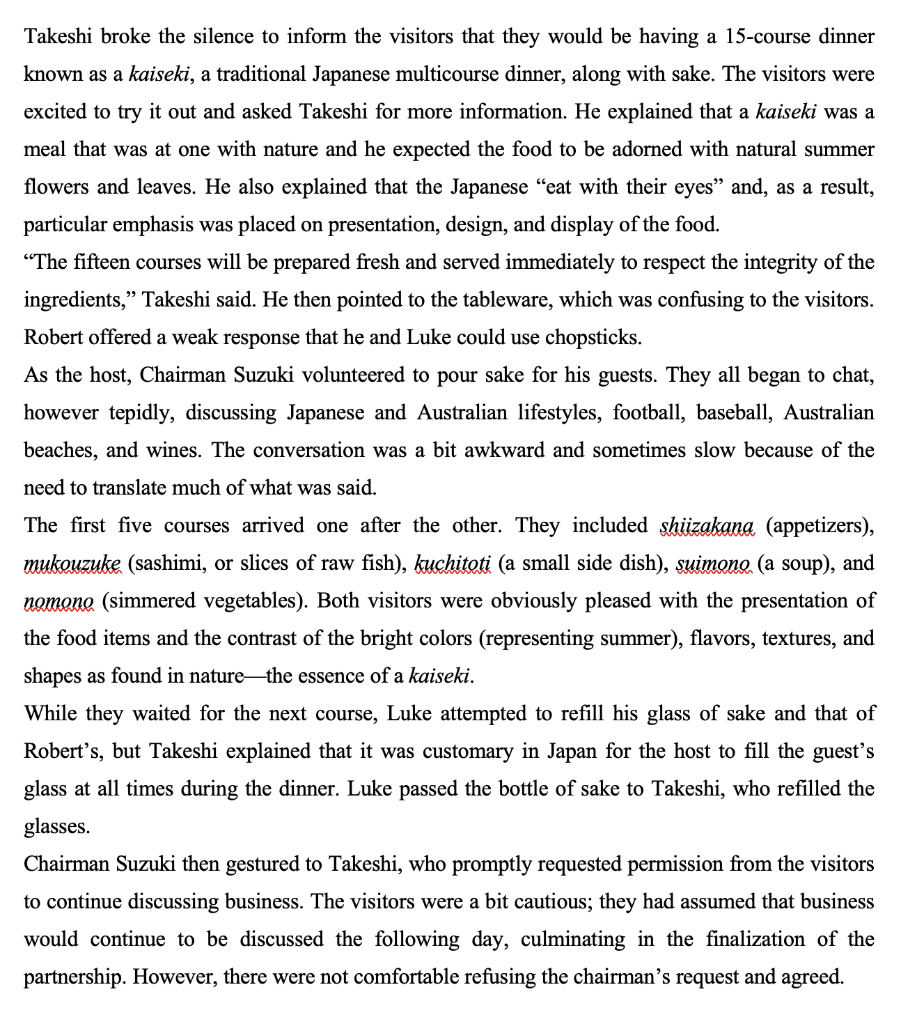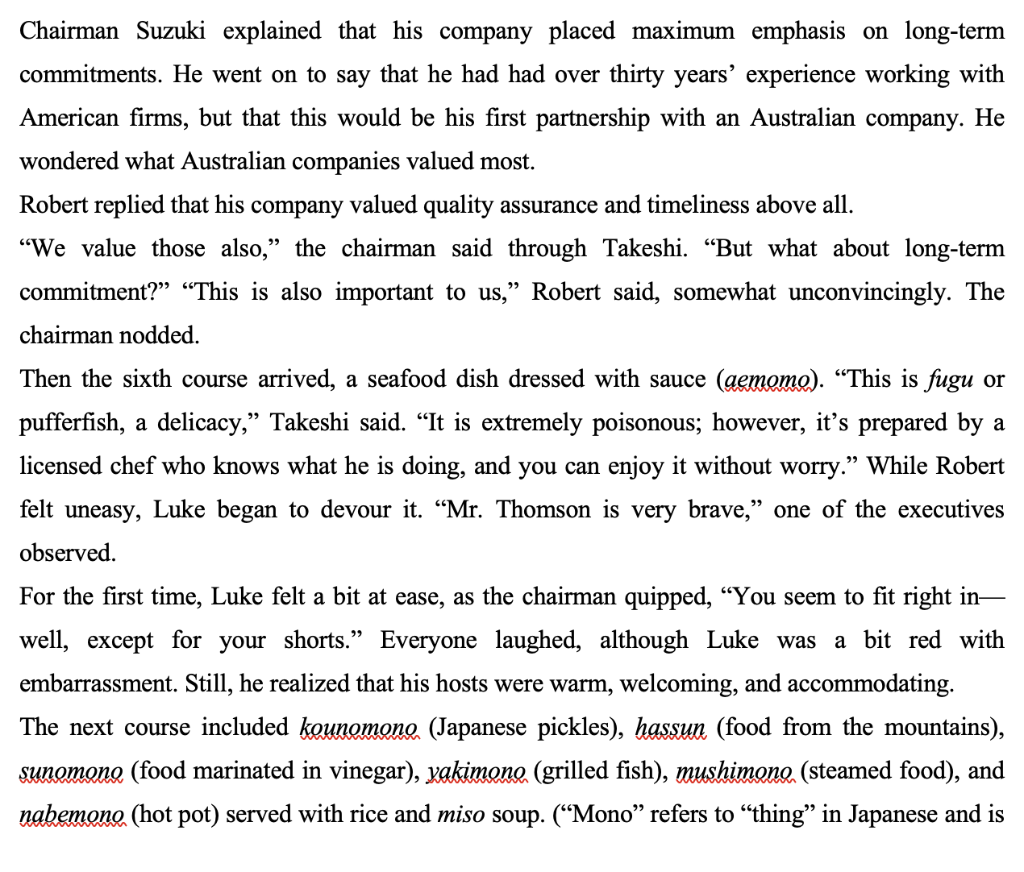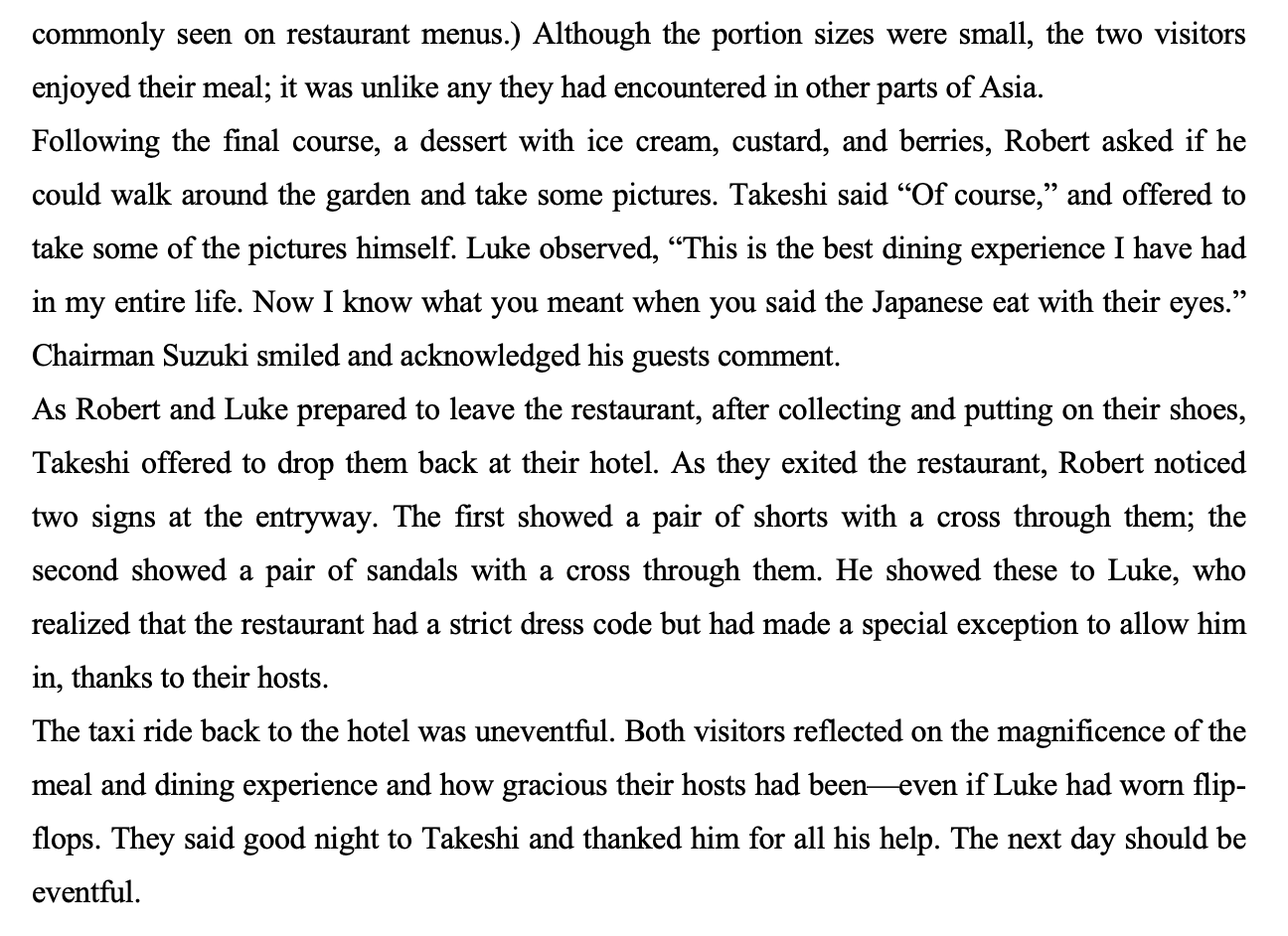Based on the case study below, please answer the following question below:
1) What cultural assumptions, if any, did each side make about the other in their approach to communicating?
2) Were these assumptions accurate? Please analyze why?






Robert Brown, Senior Vice President for Business Development of an Australian electronics firm, and his associate Luke Thompson, Vice President for Manufacturing, have been tasked to finalize the negotiations for a five-year contract with a Japanese multinational firm to supply critical electronic component parts to the Australian firm. Both managers have extensive experience negotiating contracts with suppliers from several Asian countries, and they were both confident even though this was their first experience with a Japanese firm. Robert even had somewhat of a reputation in his company for his tough negotiation tactics and for closing favorable deals quickly. After their arrival in Tokyo, the first day of negotiations went smoothly, and both sides seemed happy with the progress. Robert was particularly satisfied with the terms and conditions that had been discussed. As the day drew to a close, their Japanese counterparts, Takeshi Miyamoto and Yoshi Shimizu, invited the Australians to continue discussions over dinner at a popular local Japanese restaurant in Shinjuku. Robert and Luke were given an hour to return to their hotel and relax before their hosts would pick them up and take them to the restaurant. They quickly got into a taxi and returned to their hotel. The agreed to meet in the lobby five minutes before the scheduled pick-up time. Robert called his wife in Melbourne to update her on his experiences in Tokyo. He then changed into his suit and tie and headed downstairs. Meanwhile, Luke watched a little TV before getting dressed, wearing a Hawaiian shirt, short pants, and flip-flops to accommodate the hot July weather. The dinner has been described as casual and relaxing, and he planned to enjoy it. He then headed for the elevator. When Luke stepped off the elevator in the lobby, he joined Robert, who was standing with Takeshi Miyamoto and Yoshi Shimizu discussing Japanese sake. Both the Japanese men seemed taken aback by Luke's casual attire. Their view of a "casual" business dinner was obviously more formal than that of Luke's, but they said nothing that might offend their guests. Takeshi and Yoshi then escorted their guests to a car to take them to the restaurant. The visitors were told en route that the company's chairmen would join them for dinner, something the visitors had not expected. Once in the car, Robert whispered to Luke, "I'm not sure our hosts are very pleased with your attire." "Why is the chairman coming?" Luke replied. "I thought we were meeting him tomorrow to finalize the deal." "Not sure," Robert whispered. Luck continued, "And when did this dinner become a business meeting? I thought we were just going for a casual dinner-that's what they said." After about forty minutes in the car, they arrived at their venue, an exquisite Japanese garden restaurant. They were greeted at the door by two Japanese women dressed in traditional kimonos and asked to remove their shoes and place them in a designated space. It is customary for guests to keep their socks on, but Luke was embarrassed that he was not wearing any and was standing barefoot. Takeshi was taken aside by one of the women for a discussion. They were joined by a man who appeared to be the manager and he was obviously upset about something. Within a few minutes, the woman brought a new pair of socks to Luke, who promptly put them on. The four executives were then escorted through a beautiful Japanese garden with an immaculate water feature-a bridge over an artificial stream with several koi swimming around-as they made their way to a private room with a traditional Japanese dining setting where they were expected to sit on the floor on bamboo tatami mats. This comes as a shock to both Australians, as they have never seen this arrangement before, even in their travels though Asia. They both look stunned. "How are we supposed to sit there?" they both thought to themselves. Their next shock was that their private dining room was filled with five additional Japanese men, all dressed in expensive business suits and ties. Takeshi introduced them one by one to Robert and Luke, beginning with the chairman, Hideo Suzuki, who bowed and welcomed them both. He was surprised, however, to see Luke was shorts and whispered something in Japanese to Takeshi who nodded in reply. The two seemed to be conversing exclusively with facial gestures. The two foreigners both shook hands with the chairman and the other four executives, and then took their seats on the floor. Takeshi explained that the chairman was not confident with his English and volunteered to act as a translator to facilitate any discussions between them. Chairman Suzuki and his four colleagues then presented their business cards one by one to the visitors, who accepted them with both hands, a custom they learned in their other travels in Asia. They noted that the cards were printed on both sides, one in Japanese and one in English. Robert then reciprocated by presenting his business card to the chairman and his colleagues, who flipped the cards over only to realize that they were one-sided and in English only. The chairman seemed to struggle to read Robert's card so Takeshi promptly translated Robert's position and title for him. Luke then apologized and explained that he left his business cards in the hotel room. This was followed by an uncomfortable silence in the room. Takeshi broke the silence to inform the visitors that they would be having a 15 -course dinner known as a kaiseki, a traditional Japanese multicourse dinner, along with sake. The visitors were excited to try it out and asked Takeshi for more information. He explained that a kaiseki was a meal that was at one with nature and he expected the food to be adorned with natural summer flowers and leaves. He also explained that the Japanese "eat with their eyes" and, as a result, particular emphasis was placed on presentation, design, and display of the food. "The fifteen courses will be prepared fresh and served immediately to respect the integrity of the ingredients," Takeshi said. He then pointed to the tableware, which was confusing to the visitors. Robert offered a weak response that he and Luke could use chopsticks. As the host, Chairman Suzuki volunteered to pour sake for his guests. They all began to chat, however tepidly, discussing Japanese and Australian lifestyles, football, baseball, Australian beaches, and wines. The conversation was a bit awkward and sometimes slow because of the need to translate much of what was said. The first five courses arrived one after the other. They included shizakana (appetizers), mukouzuke (sashimi, or slices of raw fish), kuchitoti (a small side dish), suimono (a soup), and nomono (simmered vegetables). Both visitors were obviously pleased with the presentation of the food items and the contrast of the bright colors (representing summer), flavors, textures, and shapes as found in nature - the essence of a kaiseki. While they waited for the next course, Luke attempted to refill his glass of sake and that of Robert's, but Takeshi explained that it was customary in Japan for the host to fill the guest's glass at all times during the dinner. Luke passed the bottle of sake to Takeshi, who refilled the glasses. Chairman Suzuki then gestured to Takeshi, who promptly requested permission from the visitors to continue discussing business. The visitors were a bit cautious; they had assumed that business would continue to be discussed the following day, culminating in the finalization of the partnership. However, there were not comfortable refusing the chairman's request and agreed. Chairman Suzuki explained that his company placed maximum emphasis on long-term commitments. He went on to say that he had had over thirty years' experience working with American firms, but that this would be his first partnership with an Australian company. He wondered what Australian companies valued most. Robert replied that his company valued quality assurance and timeliness above all. "We value those also," the chairman said through Takeshi. "But what about long-term commitment?" "This is also important to us," Robert said, somewhat unconvincingly. The chairman nodded. Then the sixth course arrived, a seafood dish dressed with sauce (aemomo). "This is fugu or pufferfish, a delicacy," Takeshi said. "It is extremely poisonous; however, it's prepared by a licensed chef who knows what he is doing, and you can enjoy it without worry." While Robert felt uneasy, Luke began to devour it. "Mr. Thomson is very brave," one of the executives observed. For the first time, Luke felt a bit at ease, as the chairman quipped, "You seem to fit right inwell, except for your shorts." Everyone laughed, although Luke was a bit red with embarrassment. Still, he realized that his hosts were warm, welcoming, and accommodating. The next course included kounomono (Japanese pickles), hassun (food from the mountains), sunomono (food marinated in vinegar), yakimono (grilled fish), mushimono (steamed food), and nabemono (hot pot) served with rice and miso soup. ("Mono" refers to "thing" in Japanese and is commonly seen on restaurant menus.) Although the portion sizes were small, the two visitors enjoyed their meal; it was unlike any they had encountered in other parts of Asia. Following the final course, a dessert with ice cream, custard, and berries, Robert asked if he could walk around the garden and take some pictures. Takeshi said "Of course," and offered to take some of the pictures himself. Luke observed, "This is the best dining experience I have had in my entire life. Now I know what you meant when you said the Japanese eat with their eyes." Chairman Suzuki smiled and acknowledged his guests comment. As Robert and Luke prepared to leave the restaurant, after collecting and putting on their shoes, Takeshi offered to drop them back at their hotel. As they exited the restaurant, Robert noticed two signs at the entryway. The first showed a pair of shorts with a cross through them; the second showed a pair of sandals with a cross through them. He showed these to Luke, who realized that the restaurant had a strict dress code but had made a special exception to allow him in, thanks to their hosts. The taxi ride back to the hotel was uneventful. Both visitors reflected on the magnificence of the meal and dining experience and how gracious their hosts had been-even if Luke had worn flipflops. They said good night to Takeshi and thanked him for all his help. The next day should be eventful












